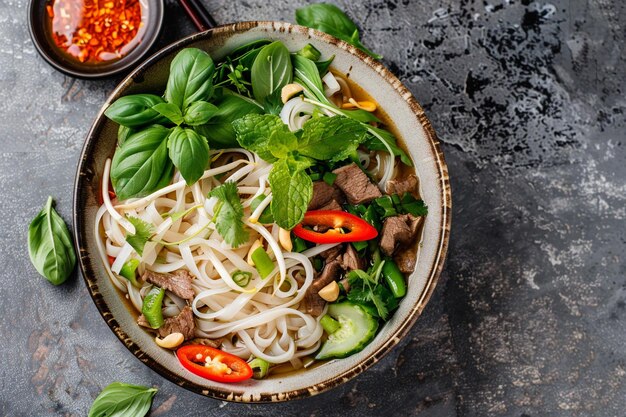Pho (pronounced “fuh”) is one of Vietnam’s most beloved dishes, a fragrant and flavorful noodle soup that is as comforting as it is delicious. Traditionally enjoyed as a breakfast in Vietnam, pho consists of a rich, aromatic broth, tender rice noodles, and an assortment of fresh herbs and proteins, typically beef or chicken. Making pho at home may seem intimidating, but with the right ingredients and a bit of patience, you can recreate this iconic dish in your kitchen.
Here’s how to make traditional Vietnamese pho from scratch.
Ingredients for Beef Pho (Pho Bo):
For the Broth:
- 4 lbs beef bones (preferably marrow bones and oxtail for a rich broth)
- 1 onion, peeled and halved
- 1 piece of ginger (about 4 inches), halved
- 2-3 cinnamon sticks
- 4-5 star anise
- 4-5 cloves
- 1 tbsp coriander seeds
- 1-2 tsp fennel seeds (optional)
- 1/4 cup fish sauce
- 1 tbsp sugar
- 10 cups water
- Salt to taste
For the Pho:
- 1 lb rice noodles (pho noodles)
- 1/2 lb beef sirloin or flank steak, thinly sliced against the grain
- Fresh herbs for garnish: Thai basil, cilantro, and mint
- 2-3 spring onions, thinly sliced
- 1 lime, cut into wedges
- Bean sprouts
- Fresh chili peppers (optional)
- Hoisin sauce and sriracha for serving (optional)
Equipment:
- Large pot or stockpot
- Fine-mesh strainer or cheesecloth (for broth)
- Ladle or tongs
- Soup bowls
Instructions:
1. Prepare the Broth:
Making pho broth requires some time, but it’s worth the effort for the depth of flavor it imparts.
- Roast the Aromatics: Begin by roasting the onion and ginger. Place them on an open flame (using a grill, broiler, or directly over the stove) until they’re slightly charred. This step helps develop the broth’s aromatic depth. If you don’t have an open flame, you can also roast them in a dry skillet or in the oven at 400°F (200°C) for about 10 minutes.
- Blanch the Bones: In a large pot, bring 10 cups of water to a boil. Add the beef bones, and boil for about 5-10 minutes. Then, drain and rinse the bones under cold water. This step removes impurities and helps you achieve a clearer broth.
- Simmer the Broth: Return the bones to the pot and add the 10 cups of fresh water. Add the roasted onion, ginger, cinnamon sticks, star anise, cloves, coriander seeds, fennel seeds, fish sauce, and sugar. Bring the pot to a boil over high heat, then lower the heat to a simmer. Skim off any scum or impurities that float to the surface to keep the broth clear.
- Cook for Flavor: Let the broth simmer uncovered for at least 3-4 hours. The longer you simmer, the richer the flavor will be. If you’re short on time, simmer for at least 2 hours. Add salt to taste as the broth simmers. After 3-4 hours, strain the broth using a fine-mesh strainer or cheesecloth, discarding the solids. Set the broth aside.
2. Prepare the Rice Noodles:
- Bring a large pot of water to a boil. Add the pho rice noodles and cook according to the package instructions, typically about 4-5 minutes for fresh noodles. Drain the noodles and set them aside.
3. Prepare the Beef:
- Thinly slice the beef sirloin or flank steak against the grain. The meat should be as thin as possible to cook quickly in the hot broth when it’s served.
4. Assemble the Pho:
- In each bowl, place a generous portion of the cooked rice noodles.
- Arrange the raw, thinly sliced beef on top of the noodles. The heat of the broth will cook the beef slices quickly, ensuring that it’s tender and just slightly pink.
- Pour the hot broth over the noodles and beef, making sure everything is submerged. The hot broth will cook the thin slices of beef to perfection in just a few seconds.
5. Garnish and Serve:
- Serve the pho with fresh herbs on the side, including Thai basil, cilantro, and mint. Guests can add herbs to their bowls to taste.
- Offer lime wedges, bean sprouts, sliced chili peppers, hoisin sauce, and sriracha on the side for extra flavor and customization.
- For a traditional pho experience, encourage guests to mix in their hoisin and sriracha for a perfect balance of sweet, spicy, and savory.
Tips for the Best Pho:
- Quality Bones: Use a combination of marrow bones, oxtail, and/or knuckle bones for a rich and gelatinous broth. The collagen in these bones gives pho its signature silky texture.
- Simmer Slowly: The longer you let the broth simmer, the more flavor you’ll extract from the bones and spices. Be patient, as this is the key to a deep, flavorful broth.
- Fresh Noodles: If possible, use fresh pho noodles instead of dried ones. Fresh noodles are much softer and provide a better texture in the soup.
- Customize Your Toppings: Pho is all about customization. Add extra toppings like fried shallots, cilantro, or even a fried egg to make your pho unique.
Making traditional Vietnamese pho at home is a rewarding process that allows you to savor the authenticity of this beloved dish. While the broth requires some time and care, the end result is well worth the effort. With a rich, aromatic broth, tender beef, and fresh garnishes, your homemade pho will transport you straight to the heart of Vietnam. Whether you’re serving it for breakfast, lunch, or dinner, pho is a comforting and satisfying meal that everyone can enjoy.








